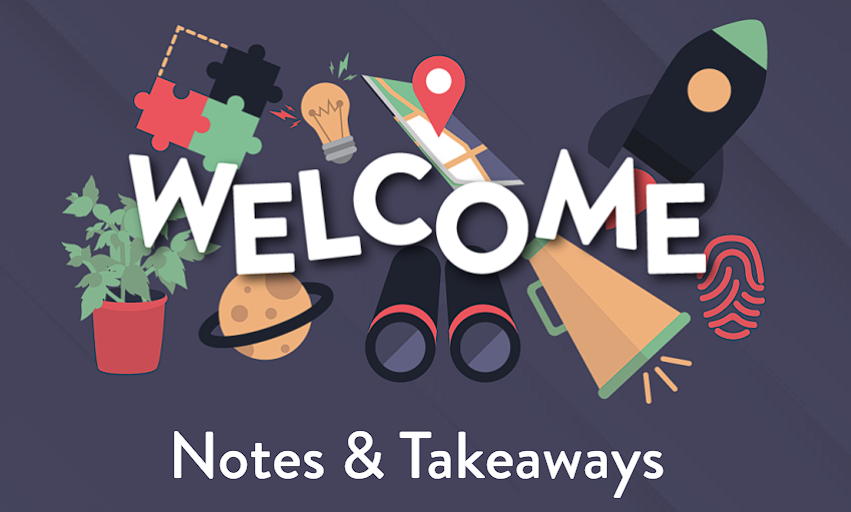2023 National Conference Keynote: The Right Environment: Creating Belongingness in the Classroom
Posted on October 1, 2023 in Issue 1: Fall, Kodály Envoy, Volume 50
Tags: Featured Articles, National Conference, Public Articles
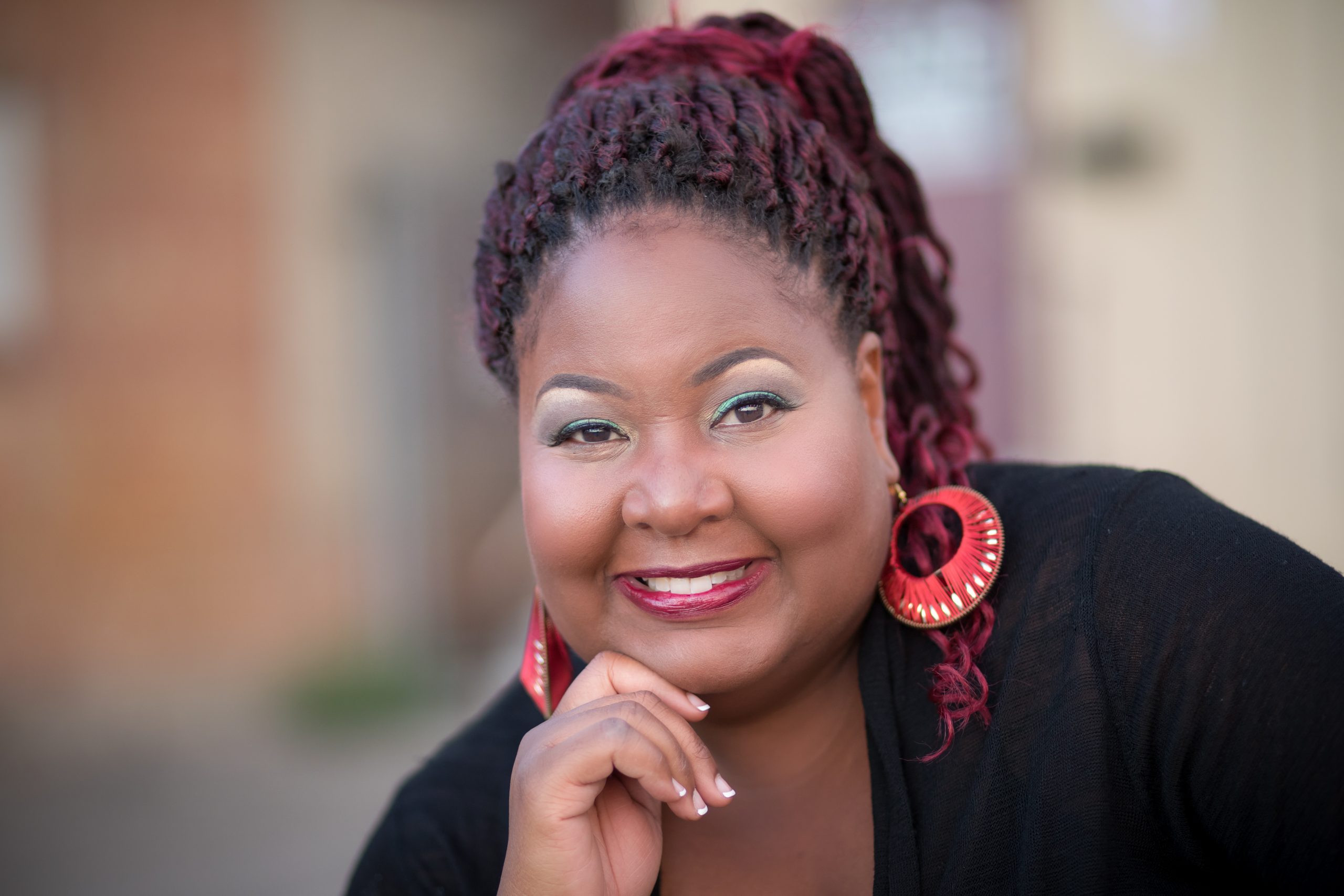 Dr. Nicole R. Robinson, Founder and CEO
Dr. Nicole R. Robinson, Founder and CEO
Cultural Connections by Design
Ladies and gentlemen,
Thank you for the opportunity to serve as your 2023 Keynote speaker for the National Organization of American Kodaly Educators (OAKE) conference here in Jacksonville, Florida. It is an honor to stand before you today and embark on a journey together, delving into the intricacies of a topic that lies at the heart of our shared passion—the topic of inclusion in the music classroom.
In the realm of music education, where harmonies are woven, melodies dance, and rhythms resonate, the concept of inclusion takes on a profound significance. Music has the extraordinary power to unite, to bridge divides, and to amplify the voices of all who participate. It is not only a form of artistic expression but also a universal language that knows no boundaries. Yet, as educators committed to nurturing the talents of our students and fostering a lifelong love for music, we must recognize that not all paths to musical discovery are the same.
Today, we will explore the multifaceted dimensions of inclusion in our music classrooms. We will embark on a journey that goes beyond the notes on a staff or the beats of a drum, one that leads us to a deeper understanding of how we can create environments where every student, regardless of their background, abilities, or challenges, can find their place on the journey of music learning.
Working alongside music educators is always a privilege to me, as I firmly believe that what we do every day with our young learners mirrors the fundamental principles of fostering inclusion and belonging. As musicians, we dedicate ourselves to perfecting our craft, honing our skills, and ensuring our students are well-prepared for performances and concerts. While we strive for perfection, knowing that “perfection” is an elusive goal, the act of sharing our music – our gift – as imperfect as it may be, is ultimately the gift we share with others. It is the selfless act of giving – which we do on an ongoing basis – that prepares us with the ability to create strong cultures of belonging as the process of creating belongingness is merely an act of giving up something of ourselves on behalf of others.
Now, I may be a little biased as a music educator myself! (Audience laughter)
Defining Terms
Before delving into this topic of “The Right Environment: Creating Belongingness in the Music Classroom,” I want to establish a baseline of clear definitions for our conversation. Although I’m certain these are possibly common words in your vocabulary, it is important that I know we’re speaking from the same lens today.
The first term I’d like to define is “diversity.” Diversity encompasses all the ways in which we are unique, emphasizing that every individual contributes to it. It’s crucial to understand that we are all an integral part of diversity. Often, people mistakenly associate diversity exclusively with factors such as not being White, male, heterosexual, etc. However, it’s essential to emphasize that every individual, regardless of their background or characteristics, contributes to diversity’s richness – all individuals are part of it. We are all a part of diversity.
I emphasize the definition of “diversity” because it forms the foundation for all efforts aimed at creating belongingness in spaces and communities. It is important that we shift our perspective on what the word “diversity” represents. Now that we’re clear that diversity includes everyone, it allows us to shift the paradigm of our work. It shifts our mindset from we’re doing this work “on behalf of those people over there” to we are doing this work “on behalf of all of us.” Additionally, when we accept that we’re all intricate members of a diverse collective, the ownership of the work no longer rests on the shoulders of a few; instead, the work becomes the responsibility of everyone.
The next term I would like to define is “inclusion.” Inclusion pertains to how we, as diverse individuals, engage with one another within specific spaces. In today’s world, we have not actualized a reality where everyone feels included within specific spaces, regardless of who they are. Now, I personally believe – of course, this is MY opinion – that the reason we have not been able to accomplish the goal of “inclusion” is due to the “unwritten rule” that places the expectation that individuals who seek inclusion into a space should bear the responsibility for achieving it.
I often describe this expectation akin to saying, “You can play in my sandbox, but only if you adhere to my norms and rules and ensure my comfort remains paramount.” To date, we have not fully realized the concept of “inclusion,” and I believe the challenge lies in determining who should be responsible for fostering inclusion. Should it be those who control the space or those who are invited to participate in it? Although I believe inclusion is the responsibility of those who control the space, unfortunately, the burden is often placed on those who are invited into it.
Now, let’s explore the notion of a “culture of belonging.” Within a “culture of belonging” framework, individuals connect and contribute meaningfully, authentically, and uniquely to the overarching goals and values of the space. You see, when I step into a space that is centered with a culture of belonging, I can bring my complete, unreserved self into the space, offering the very best of what I can contribute. Furthermore, I posit that the primary distinction between an
inclusive environment and one that prioritizes belongingness lies in who assumes the responsibility for shaping the atmosphere. In robust cultures of belonging, those who govern the space take ownership of creating a culture of belonging, rather than relying solely on those who are invited in.
It is crucial to differentiate between these definitions as we endeavor to cultivate cultures of belonging within the music classroom. We must recognize that each facet of diversity, equity, inclusion, and belonging plays a pivotal role in shaping the optimal learning environment for our music students. Diversity holds significance in acknowledging who students are, as individuals, and what they bring to the classroom as we embrace the richness of their individual identities.
Equally important is the recognition that inclusion is a top priority as it guides their active and valued participation within our music classrooms. However, our ultimate responsibility as music educators lies in creating a culture of belonging in the music classroom. This enables our students to wholeheartedly contribute the best of themselves to the space, allowing them to fully embrace their musical learning journey.
Lastly, I firmly believe in the concept of an equity-centered culture that goes beyond the bounds of a culture of belonging. An equity-centered culture ensures that the space operates under policies, practices, and procedures that prioritize equity. Frequently, we mistakenly intermingle the terms equity and equality, so allow me to distinguish between them.
Equity and equality are two distinct principles that are cornerstones in the realm of social justice and fairness. Equality typically entails the notion of providing everyone with identical resources, opportunities, or treatment, irrespective of their individual circumstances or requirements. It seeks to establish uniformity and treat all individuals in the same manner, striving for a level playing field.
To illustrate, consider my images here of three distinct plants: a succulent (or cactus), a lily plant, and a fern plant. Now, imagine that I am giving each of them equal amounts of water. Although water is an essential substance, we observe that excessive water for the succulent plant proves detrimental; it withers and decays. The lily plant, despite having some blooms, appears droopy, suggesting it may not be receiving the care it requires. In contrast, the fern plant thrives because it receives the appropriate amount of water. This example illustrates that while equality aims to provide the same, it may inadvertently harm or hinder those with different needs, highlighting the importance of equity in tailoring resources and support to individual requirements. While equality is essential in certain contexts, it may not always address the disparities that exist due to historical disadvantages, differing abilities, or varying circumstances. In essence, equality strives to ensure that everyone receives the same, but it may not guarantee that everyone has an equal chance to succeed.
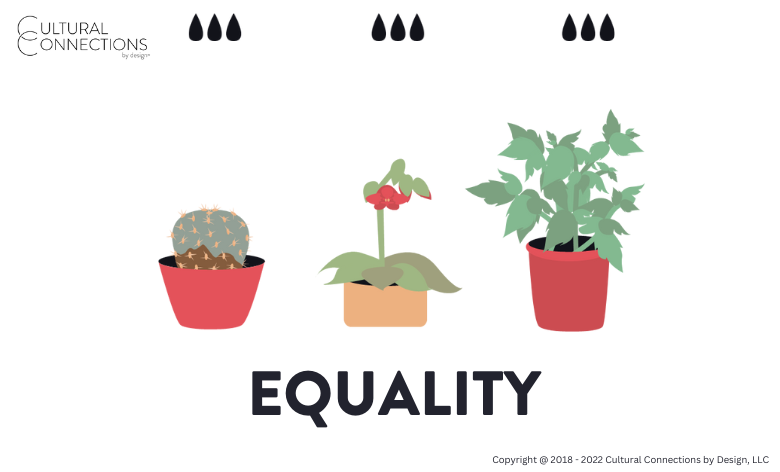
On the other hand, equity emphasizes the principle of fairness by recognizing and addressing the unique needs and circumstances of individuals or groups. It acknowledges that people start from different points in life and that true fairness requires providing resources, opportunities, or support in a manner that levels the playing field and rectifies historical or systemic inequalities.
Let’s take a closer look at my plants. I’ve adjusted my watering approach: the succulent plant, or cactus, now receives one part water, the lily plant gets two parts water, and the fern plant still gets its consistent three parts of water. What you’ll notice is that the succulent, despite receiving less water, is flourishing as it now receives precisely what it requires – it requires less in this circumstance. There’s no more decay, it is full and succulent and it’s even blooming. The lily plant, which was initially just blooming, is now thriving with multiple blooms with its decreased water supply to only two-part water. Meanwhile, the fern plant, consistently receiving the right amount of water, continues to thrive as it always has because it received what it needed.
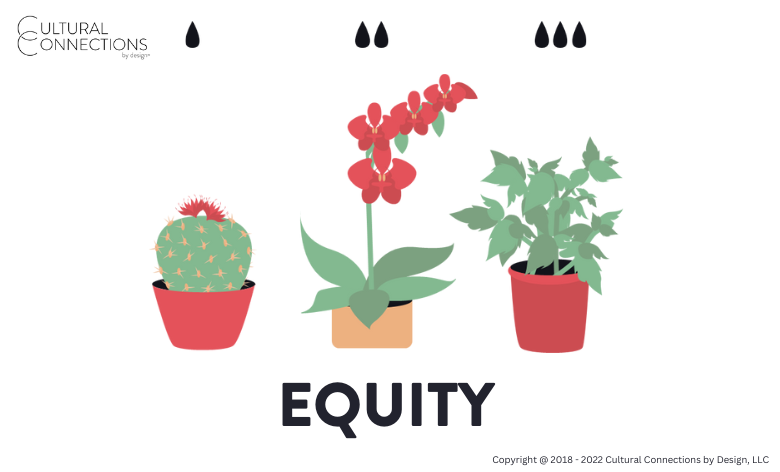
Equity aims to create a just society by actively working to eliminate the barriers that hinder some individuals or groups from achieving the same outcomes as others. In essence, equity seeks to achieve fairness by addressing and rectifying disparities, thereby ensuring that everyone has an equal opportunity to thrive.
Creating the “Right Environment” in the Music Classroom
Now, let’s embark on a journey to discover the essential steps in building an inclusive music classroom, where every student feels a deep sense of belonging and can thrive. Our focus will revolve around what I call the four “P’s” or the “Essential Pieces” of belonging. The four “P’s” – People, Place, Process, and Power – are the cornerstone components of creating an environment where diversity is celebrated, collaboration is encouraged, and music becomes a unifying force. As music educators, embracing the principles of diversity, equity, inclusion, and belongingness will not only enrich your teaching practices but also empower your students to explore the vast and beautiful world of music.
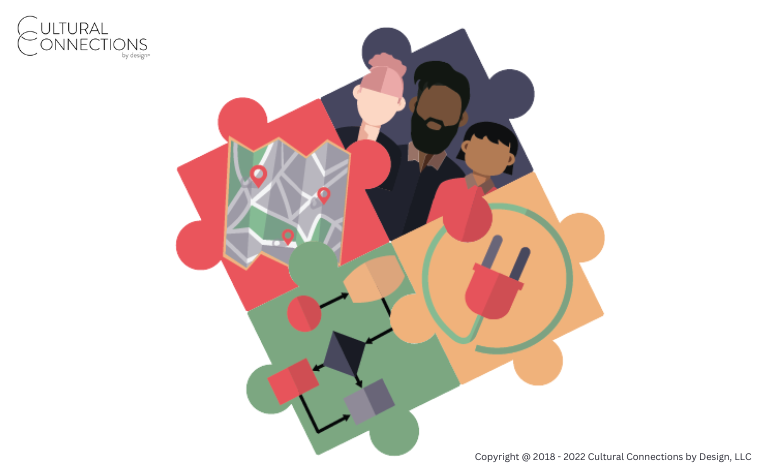
People
Let’s delve into the heart of building a culture of belonging—”people.” Within the realm of music education, understanding the pivotal role of individuals is paramount. Every student who walks through your classroom door is a unique individual with their own musical journey, talents, and stories. Recognizing and celebrating this diversity is at the core of fostering a culture of belonging in the music classroom. Thus, each student should be seen, valued, and respected for who they are, their background, and their musical aspirations. By doing so, you create a space where every student feels like they truly belong in the world of music.
In essence, “people” – your students – are the heart and soul of your music classroom. Their presence, diverse backgrounds, and unique talents bring vitality and richness to the music learning journey you embark on together. Creating a culture of belonging in the music classroom ultimately prioritizes your students’ growth and well-being, creating a thriving and nurturing space for their musical exploration and development.
Place
Next, we will discuss the second “P”— “place.” In your role as music educators and within your music classrooms, please recognize the paramount importance of “place” in fostering a culture of belonging. The physical environment you create significantly influences how students perceive and experience their sense of inclusion. The concept of “place” here is not just about the physical layout of your classroom but also what your classroom represents symbolically for your students. It’s about ensuring that every student feels genuinely welcomed, valued, and included within your musical community.
When you invest in creating a thoughtfully designed, inclusive physical and emotional space, you send a powerful message to your students that they, regardless of their backgrounds, abilities, or identities, have a rightful and valued place both in your classroom and within the world of music. This tangible representation of inclusivity not only enhances the learning experience but also nurtures a sense of belonging that can profoundly impact your students’ musical journeys.
Process
Let’s explore the concept of “process.” In your journey to create an inclusive musical environment, the processes you employ within your classroom carry immense significance. These processes encompass every aspect of the teaching and learning process from how you teach music, design your lessons, and engage with your students. They should be thoughtfully crafted with inclusivity in mind, ensuring that every student, regardless of their background or abilities, can actively participate and flourish in your musical setting.
Consider the teaching methodologies you employ, such as Kodály. Are they adaptable to cater to diverse learning styles and abilities? What are your processes for handing out instruments, distributing music, or conducting assessments? Are these processes equitable? By examining and modifying all your processes to be more inclusive, you pave the way for every student to access the transformative power of music education in your classroom. Additionally, you foster an environment where students feel that their unique perspectives and needs are not just acknowledged but celebrated. In essence, “process” in your music classroom is the key to unlocking the full potential of each student’s musical journey, ensuring that everyone finds their voice and a sense of belonging in music education.
Power
Let’s delve into a critical aspect of nurturing a culture of belonging – the concept of “power.” Within the realm of music education, the authority and influence you possess as educators are instrumental in shaping inclusivity and equity within your classroom. Recognizing and leveraging this power positively can have a profound impact on your students’ sense of belonging.
Acknowledging your authority means not only providing musical instruction but also creating an environment where students learn to exercise their own power and feel their voices are valued.
Encouraging student empowerment by involving them in decisions about the classroom’s musical direction, repertoire choices, and teaching methods can be transformative. This shift from a top-down approach to a more collaborative and inclusive one not only promotes shared ownership but also fosters an atmosphere where students can flourish as active contributors to the musical community. By using your power to promote inclusion, you help your students recognize their own potential and find their unique place within the harmonious tapestry of music education.
Conclusion
In conclusion, I want to express my deepest gratitude to each and every one of you for joining me on this insightful and inspiring journey today. Our time together has reaffirmed the profound impact that inclusion can have in the music classroom. It is through our collective dedication to these principles that we can shape the future of music education.
Thank you once again for allowing me to join you on this journey towards creating inclusive and equitable music classrooms. Together, through our commitment to embracing diversity, fostering a sense of belonging, and nurturing a culture of inclusion, we can empower the next generation of musicians to find their voices, create harmonious melodies, and contribute to a world where music truly knows no boundaries.
As I closed, I came bearing a “gift” (audience laughter). Yes, as a Southerner, I was raised with the tradition of never visiting someone’s home without a gift. First and foremost, I’d like to offer you a link to our “30-day Small Steps, Big Change” Action Planner.” This planner is designed to guide you through one small, impactful step each day, empowering you to initiate positive change within your music classrooms. Please allow it to resonate with you that it only takes one small step to set in motion a wave of transformation.
Additionally, I want to share a link with you, providing access to all the notes and takeaways from the insights I’ve shared during today’s keynote address. Feel free to revisit these notes anything when needed to refresh yourself on what we discussed today.
Finally, as you return to your classrooms and communities, remember that the work we do is not just about teaching music; it’s about inspiring and uplifting the human spirit. It’s about giving every student the chance to shine and helping them discover the magic of music. Together, we can make this vision a reality, one note, one chord, and one student at a time.
Bio
Dr. Nicole R. Robinson is a trailblazer in the field of equity and diversity, with a distinguished career spanning over 22 years in academia. Prior to launching Cultural Connections by Design in September 2018, Dr. Robinson held the position of Associate Vice President for Equity and Diversity at the University of Utah in Salt Lake City, UT. Her commitment to fostering inclusive environments and championing diversity extends beyond administrative roles, as she has also made significant contributions as an educator. Notably, Dr. Robinson served as the Beverley Taylor Sorenson Presidential Endowed Professor of Music Education at the University of Utah and has held faculty positions at the University of Memphis, Syracuse University, and Virginia Commonwealth University. Her multifaceted career exemplifies her dedication to promoting equitable access to music education and creating spaces where all students can experience academic success.
Click here to read Nicole’s “Notes & Takeaways” from the 2023 National Conference
 |
Share this article to Facebook |

We hope you’ve enjoyed reading this public article from the Kodály Envoy. Interested in reading more?
OAKE Members get access to the entire Envoy archive; 50+ years of Kodály-focused articles and research.

